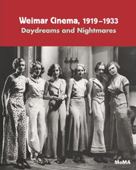
Books on the silent era of cinema.
Copyright © 1999-2025
by Carl Bennett
and the Silent Era Company.
All Rights Reserved. |
|
Weimar Cinema, 1919-1933
Daydreams and Nightmares
By Laurence Kardish
|

|
BRIEF NOTES
Weimar Cinema, 1919-1933: Daydreams and Nightmares
By Laurence Kardish
The Museum of Modern Art : New York, New York : 2010
Trade Paperback Edition : ISBN 978-0870707612 : 224 pages
$39.95
|
|
Published in conjunction with The Museum of Modern Art's presentation of 75 feature-length films from the Weimar era, many only recently restored, Weimar Cinema reconsiders the broad spectrum of influential films made in Germany between the World Wars. German and American films competed on the world market, and the stylistic accomplishments of the many German film artists who emigrated to Hollywood before Hitler took power deeply affected American cinema.
Weimar Cinema is the first comprehensive survey of this period to include popular films — musicals, comedies, the ‘daydreams’ of the working class — along with the nightmarish classics such as Fritz Lang’s Dr. Mabuse der Spieler (1922) and M (1931); F.W. Murnau’s Nosferatu, eine Symphonie des Grauens (1922); and G.W. Pabst's Pandora's Box (1929).
Richly illustrated with film stills, the book examines how and why our understanding of these films has changed in the last half century, and investigates important themes in films from this period, including the portrayal of women and the role of sound.
Supplementing the essays is a detailed illustrated filmography of the 75 films featured in the exhibition; each film is accompanied by a brief description and excerpts from contemporaneous reviews.
|
|
This book is available directly from . . .
|

|
|
|
|
Silent Era Home Page > Books > Weimar Cinema, 1919-1933
|




































